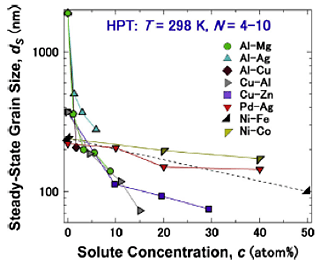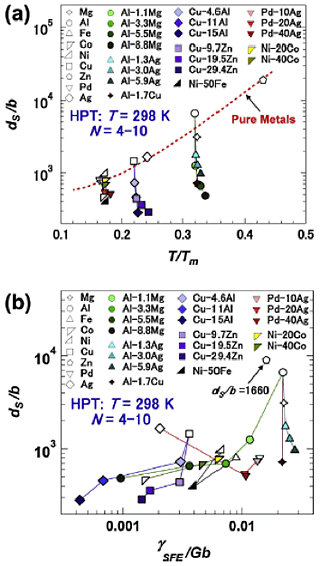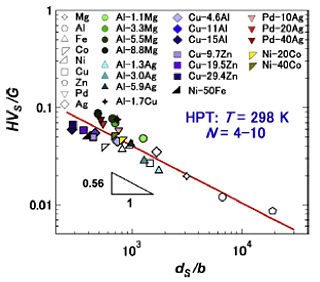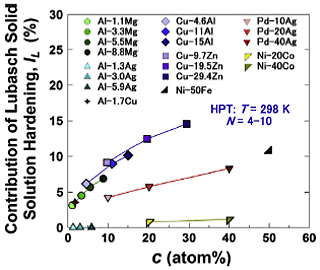Influence of dislocation solute atom interactions and stacking fault energy
on grain size of single-phase alloys after severe plastic deformation
using high-pressure torsions
solute atom interactions and stacking fault energy
on grain size of single-phase alloys after severe plastic deformation
using high-pressure torsions
Several pure metals (magnesium, aluminum, iron, cobalt, nickel, copper, zinc, palladium and silver) and single-phase Al Mg, Al
Mg, Al Ag, Al
Ag, Al Cu, Cu
Cu, Cu Al, Cu
Al, Cu Zn, Pd
Zn, Pd Ag, Ni
Ag, Ni Fe and Ni
Fe and Ni Co alloys were processed by severe plastic deformation using high-pressure torsion (HPT). The steady-state grain size was decreased and hardness increased by alloying in all the systems as shown in Fig.1. It was shown that the dominant factor for extra grain refinement by alloying was due to the effect of solute
Co alloys were processed by severe plastic deformation using high-pressure torsion (HPT). The steady-state grain size was decreased and hardness increased by alloying in all the systems as shown in Fig.1. It was shown that the dominant factor for extra grain refinement by alloying was due to the effect of solute matrix atomic-size mismatch and modulus interaction on the mobility of edge dislocations. For the selected alloys, unlike pure metals, the grain size was almost insensitive to the melting temperature as shown in Fig.2(a), and like pure metals, no systematic correlation was established between the grain size and stacking fault energy (chemical interaction) as in Fig.2(b) or between the grain size and valence electrons (electrical interaction). The presence of a power-law relation, with n = 0.56, between the hardness normalized by the shear modulus and grain size normalized by the Burgers vector as shown in Fig.3 signified the large contribution of grain boundaries to the hardening. The contribution of the solid-solution effect to the total hardening appeared to be
matrix atomic-size mismatch and modulus interaction on the mobility of edge dislocations. For the selected alloys, unlike pure metals, the grain size was almost insensitive to the melting temperature as shown in Fig.2(a), and like pure metals, no systematic correlation was established between the grain size and stacking fault energy (chemical interaction) as in Fig.2(b) or between the grain size and valence electrons (electrical interaction). The presence of a power-law relation, with n = 0.56, between the hardness normalized by the shear modulus and grain size normalized by the Burgers vector as shown in Fig.3 signified the large contribution of grain boundaries to the hardening. The contribution of the solid-solution effect to the total hardening appeared to be  15% as shown in Fig.4.
15% as shown in Fig.4.
[Published in Acta Materialia, 69 (2014) pp 68-77.]
 |
Fig. 1 Plots of dS vs. c, where dS is the steady-state grain size and c is the concentration of solute atoms. |
 |
Fig. 2 Plots of dS/b vs. (a) T/Tm and (b) |
 |
|
| Fig. 3 Plots of HVS/G vs. dS/b, where HVS is the steady-sate hardness, G is the shear modulus, dS is the steady-state grain size and b is the Burgers vector. | Fig. 4 Plots of contribution of solid-solution hardening to total hardness vs. concentration of solute atoms calculated using Labusch’s model for edge dislocations. |
